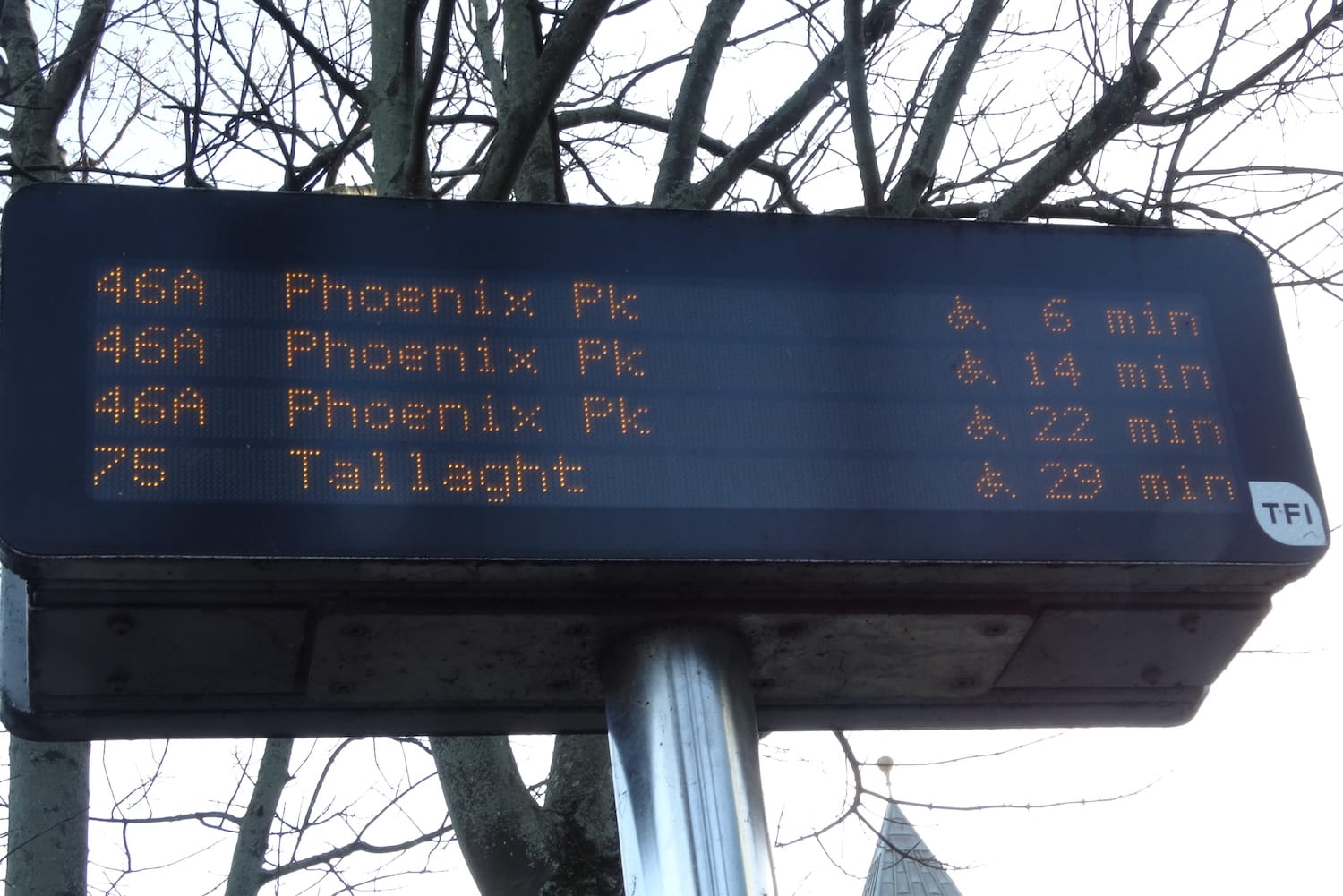What’s the best way to tell area residents about plans for a new asylum shelter nearby?
The government should tell communities directly about plans for new asylum shelters, some activists and politicians say.
In an NTA assessment from August last year, route 75 was listed in “the 5 worst performing routes in each of the previous 4 periods”.

At 11:28am on a crisp January morning, at the first stop on the 75 route in Dún Laoghaire, going to Tallaght, four people are waiting for the bus.
It’s scheduled every half hour. It looks like one’s on the way but then, for a few minutes, the next 75 disappears from the timetable.
Suddenly, it appears again. Soon, it rolls up to the stop. It was due at 11:53 but has arrived four minutes late, at 11:57.
“It’s never on time,” says Dave O’Byrne, who rides the bus four times a week and is on the 75 today.
O’Byrne is sitting at the back of the bus, his brother facing him. After a few stops, a woman beside him gets off, and his brother takes her seat.
“Sometimes it comes five minutes early, but sure that’s no use,” Dave O’Byrne says.
The 75 bus route – which runs from Dún Laoghaire to Tallaght, through Knocklyon, Foxrock, Dundrum and Ballinteer – continues to be one of the worst-performing buses for punctuality in Dublin, according to Go-Ahead Ireland figures.
In an NTA assessment report from August last year, route 75 was listed in “the 5 worst performing routes in each of the previous 4 periods. The same 5 routes are consistently bottom of the league”.
From the start of 2018 until autumn (P1 to P10 in NTA speak), Dublin Bus operated the route, and its punctuality each period ranged from 47.1 percent to 53.8 percent, according to an NTA report. That’s an average of 50.07 percent.
After Go-Ahead took over operating the route, from late winter through spring (P2 to P6, 2019) its punctuality each period ranged from 49.5 percent to 55 percent, according to an NTA report. That’s an average of 51.74 percent.
That’s a slight improvement, on average, under Go-Ahead – but still well below the 65 percent target.
Punctuality targets set out the aims for the minimum percentage of times that a bus must leave a bus stop on time – which means not more than a minute early, or not more than five minutes and fifty-nine seconds later.
Since May, Go-Ahead has faced penalties if it failed to run 65 percent or more of its buses on time.

### Why So Low?
Dún-Laoghaire Fine Gael Councillor Kazi Ahmed says he has received complaints since some routes have changed hands.
“The service is not as frequent as it has been before, since Go-Ahead [has] come in,” he says.
The 75 rolls away from Dún Laoghaire and starts to make its way west across Dublin to Tallaght. It’s not immediately clear from this journey why this bus is so often unpunctual.
There are regular stops and starts that buses encounter all over the city. Around the corner from Dún Laoghaire main street, a delivery van is parked in front of the bus stop, holding the 75 bus up for half a minute.
Another time, the bus pauses at an empty stop. Someone on board has accidentally pressed the stop button.
Liam Sinclair, a Green Party councillor in Tallaght, says he thinks the delays are down to how the roads are prioritised.
“The 75 goes through a lot of urban villages. The roads there, as with most of Dublin city, the cars are prioritised,” he said.
The bus gets stuck in congestion in residential areas where cars block up the roads, says Sinclair.
“That makes this particular route unreliable because you never know what traffic is going to be like in that particular area [that the bus route goes through],” he says.
A Go-Ahead Ireland spokesperson said similar. Route 75 “is a cross-city route that encounters a significant amount of localised congestion”, they said, by email.
“In addition, this route also has little bus-priority bus lanes. Both of these factors impact its timings and reliability,” said the spokesperson.
Sinclair, the Green Party councillor, says that not enough funding is being allocated to tackle problems like this in public transport.
“The [Green] Party has been saying for some time now that we need to prioritise public transport spending 2:1 with roads and that would be what we want to look at,” says Sinclair.
The NTA has not yet responded to a query about any discussions they have had with Go-Ahead about the 75 route.
When asked what the company plans to do about the 75 route’s lack of punctuality, a Go-Ahead spokesperson said: “As with all our routes, we are continually monitoring timetables, traffic, punctuality and overall reliability.”
“This information,” the spokesperson said, “along with feedback from customers, is incredibly important, and feeds into any potential changes we may recommend to the NTA relating to timetable changes.”
Donal O’Carroll sits at the back of the bus. He’s retired now and on his way to Clondalkin, wrapped in a scarf and gloves.
“It wasn’t exactly on time but I don’t mind,” O’Carroll says. “It’s better to have the service than not to have it at all.”
Sign up here to get our free email newsletter each Wednesday, with headlines from the week’s online edition, updates from inside the newsroom, and more. It’s a little reminder when we have a new edition out, and a way for you to stay in touch with what we’re doing without having to check social media.
Get our latest headlines in one of them, and recommendations for things to do in Dublin in the other.